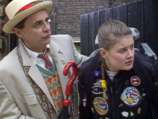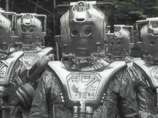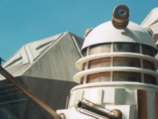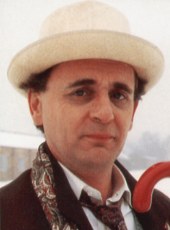| Season Start: | 05 October 1988 | | Season End: | 04 January 1989 | | Season Length: | 14 Weeks | | Writers: | Ben Aaronovitch, Graeme Curry, Kevin Clarke and Stephen Wyatt | | Directors: | Alan Wareing, Andrew Morgan and Chris Clough | | Producer: | John Nathan-Turner | | Script Editor: | Andrew Cartmel | | Visual Effects: | Perry Brahan, Steve Bowman and Stuart Brisdon | | Title Sequence: | Oliver Elmes | | Title Music: | Ron Grainer and the BBC Radiophonic Workshop. Arranged by Keff McCulloch |
|
Incarnation of the Doctor: |
The Seventh Doctor
|
| Number of
Companions: |
1 |
| The
Companions: |
Ace
|
| Number of
Stories: |
4
|
| Number of
Incomplete/Missing Stories: |
0
|
| Number of
Episodes: |
14
|
| Number of
Incomplete/Missing Episodes: |
0
|
| Percentages: |
| Full Stories Held | 100% | | Episodes Held | 100% |
|
| Doctor Who Magazine Poll (1998) | | | Doctor Who Magazine Poll (2009) | | | Doctor Who Magazine Poll (2014) | |
|
 'Your species has the most amazing capacity for self-deception, matched only by its ingenuity when trying to destroy itself.' 'Your species has the most amazing capacity for self-deception, matched only by its ingenuity when trying to destroy itself.'
The Doctor
(Remembrance of the Daleks) |
|
|
|
|
| |
 |
| The Doctor and Ace |
|
 With the start of Season Twenty Five, in October 1988, Doctor Who celebrated its silver anniversary. For this special milestone in the show’s history Producer John Nathan-Turner decided to bring back at least one of The Doctor’s two most popular nemeses: the Daleks and the Cybermen. Both, in the end, would be featured. With the start of Season Twenty Five, in October 1988, Doctor Who celebrated its silver anniversary. For this special milestone in the show’s history Producer John Nathan-Turner decided to bring back at least one of The Doctor’s two most popular nemeses: the Daleks and the Cybermen. Both, in the end, would be featured.
 This season again consisted of four stories made up of 14 twenty five minute episodes. Being the silver anniversary season, it included several stories making note of the milestone: "Remembrance of the Daleks", as well as featuring the Daleks and Davros was set in Coal Hill School and I.M. Foreman’s junkyard - settings seen in the first episode of the 1963 First Doctor story "An Unearthly Child". While "Silver Nemesis" – the actual Twenty Fifth anniversary story – featured the Cybermen. John Nathan Turner went to great lengths to make sure that the first episode "Silver Nemesis" was actually broadcast on the 23rd November 1988 – the actual Twenty Fifth anniversary of the show. This season again consisted of four stories made up of 14 twenty five minute episodes. Being the silver anniversary season, it included several stories making note of the milestone: "Remembrance of the Daleks", as well as featuring the Daleks and Davros was set in Coal Hill School and I.M. Foreman’s junkyard - settings seen in the first episode of the 1963 First Doctor story "An Unearthly Child". While "Silver Nemesis" – the actual Twenty Fifth anniversary story – featured the Cybermen. John Nathan Turner went to great lengths to make sure that the first episode "Silver Nemesis" was actually broadcast on the 23rd November 1988 – the actual Twenty Fifth anniversary of the show.
 It was originally thought that this season would begin on the 7th September 1988, but coverage of the Summer Olympics in Seoul forced a revision of these plans. In the end the first episode of this season was transmitted on the 5th October 1988. Because John Nathan-Turner also wanted to begin this season with "Remembrance of the Daleks", this left only three weeks in between "Remembrance of the Daleks" and "Silver Nemesis". As a result, "The Happiness Patrol" was moved up into this gap - so swapping places with the four-part "The Greatest Show in the Galaxy". This though resulted in a number of unforeseen continuity problems with an earring, belonging to a character called Flowerchild in "The Greatest Show in the Galaxy", being seen on Ace’s jacket before she found it and Ace searching for her rucksack after it had been destroyed in an earlier story. It was originally thought that this season would begin on the 7th September 1988, but coverage of the Summer Olympics in Seoul forced a revision of these plans. In the end the first episode of this season was transmitted on the 5th October 1988. Because John Nathan-Turner also wanted to begin this season with "Remembrance of the Daleks", this left only three weeks in between "Remembrance of the Daleks" and "Silver Nemesis". As a result, "The Happiness Patrol" was moved up into this gap - so swapping places with the four-part "The Greatest Show in the Galaxy". This though resulted in a number of unforeseen continuity problems with an earring, belonging to a character called Flowerchild in "The Greatest Show in the Galaxy", being seen on Ace’s jacket before she found it and Ace searching for her rucksack after it had been destroyed in an earlier story.
 Behind the scenes Producer John Nathan-Turner had once again had his request to be moved off Doctor Who turned down. The reason given him this time was that new Head of Drama, Peter Cregeen, wanted time to settle into his role, and did not want to make any major changes to his department. Since John Nathan-Turner was not willing to resign from the BBC, this meant that he would have to remain on Doctor Who for an eighth season. The benefit of this was that it meant there was considerable stability in the production office, allowing John Nathan-Turner and Andrew Cartmel to begin planning for the show's future. They both felt that Doctor Who had lost some of its sense of wonder, and The Doctor himself was no longer a very mysterious figure. Behind the scenes Producer John Nathan-Turner had once again had his request to be moved off Doctor Who turned down. The reason given him this time was that new Head of Drama, Peter Cregeen, wanted time to settle into his role, and did not want to make any major changes to his department. Since John Nathan-Turner was not willing to resign from the BBC, this meant that he would have to remain on Doctor Who for an eighth season. The benefit of this was that it meant there was considerable stability in the production office, allowing John Nathan-Turner and Andrew Cartmel to begin planning for the show's future. They both felt that Doctor Who had lost some of its sense of wonder, and The Doctor himself was no longer a very mysterious figure.
 Therefore beginning with Season Twenty Five they decided to take steps to restore both of these elements, aided and abetted by a number of eager new writers they had started to build up, Ben Aaronovitch amongst them. In particular, Cartmel wanted to start laying hints that there was more to The Doctor's background than had been revealed so far. Sylvester McCoy, who himself had finally had time to think more thoroughly about his portrayal of The Doctor (after being cast virtually at the last minute prior to the start of production on Season Twenty Four), was enthusiastic about this new direction for his character and worked closely with the production team in its development. And so with the start of this season the Seventh Doctor became much darker and less cartoonish. Therefore beginning with Season Twenty Five they decided to take steps to restore both of these elements, aided and abetted by a number of eager new writers they had started to build up, Ben Aaronovitch amongst them. In particular, Cartmel wanted to start laying hints that there was more to The Doctor's background than had been revealed so far. Sylvester McCoy, who himself had finally had time to think more thoroughly about his portrayal of The Doctor (after being cast virtually at the last minute prior to the start of production on Season Twenty Four), was enthusiastic about this new direction for his character and worked closely with the production team in its development. And so with the start of this season the Seventh Doctor became much darker and less cartoonish.
 The Doctor's hint, in "Remembrance of the Daleks", that he was present at the creation of the Hand of Omega, was the first outward statement of this new direction and more hints about the mystery to The Doctor's origins would surface over the next two seasons. But as the programme ceased production in 1989, the intended revelations never came to pass. The Doctor's hint, in "Remembrance of the Daleks", that he was present at the creation of the Hand of Omega, was the first outward statement of this new direction and more hints about the mystery to The Doctor's origins would surface over the next two seasons. But as the programme ceased production in 1989, the intended revelations never came to pass.
 This season also featured the first full season of stories for new companion Ace, played by Sophie Aldred, who had joined The Doctor in his travels during "Dragonfire" – the final story of Season Twenty Four. This season also featured the first full season of stories for new companion Ace, played by Sophie Aldred, who had joined The Doctor in his travels during "Dragonfire" – the final story of Season Twenty Four.
 Ace was a troubled teenager from Perivale in England. Her real name was Dorothy, but she utterly despised it - a trait effectively symptomatic of Ace's rebellious personality in general. She lacked self-confidence and was burdened by angst and turmoil. Originally, Ace found respite only in making explosives - especially her beloved homemade nitro-nine. But since joining the TARDIS, she found a new outlet for her inner rage, channelling it into destroying the evils that she and The Doctor encountered in their travels together. Ace would go on to be a prominent figure in the spinoff fiction that kept Doctor Who alive following its cancellation in 1989. Ace was a troubled teenager from Perivale in England. Her real name was Dorothy, but she utterly despised it - a trait effectively symptomatic of Ace's rebellious personality in general. She lacked self-confidence and was burdened by angst and turmoil. Originally, Ace found respite only in making explosives - especially her beloved homemade nitro-nine. But since joining the TARDIS, she found a new outlet for her inner rage, channelling it into destroying the evils that she and The Doctor encountered in their travels together. Ace would go on to be a prominent figure in the spinoff fiction that kept Doctor Who alive following its cancellation in 1989.
 As well as featuring the return of Davros, the Daleks and the Cybermen this season introduced new villains including: Helen A, the Kandy Man and the Gods of Ragnarok. However, because of the show’s cancellation in 1989 this would be the last appearance, in the original run of the show, for Davros, the Daleks and the Cybermen. It would also be the last for writer Stephen Wyatt; and also for directors Andrew Morgan and Chris Clough. As well as featuring the return of Davros, the Daleks and the Cybermen this season introduced new villains including: Helen A, the Kandy Man and the Gods of Ragnarok. However, because of the show’s cancellation in 1989 this would be the last appearance, in the original run of the show, for Davros, the Daleks and the Cybermen. It would also be the last for writer Stephen Wyatt; and also for directors Andrew Morgan and Chris Clough.
 This season though was the first for writer Ben Aaronovitch – who would write one further televised Doctor Who story and would go on to write numerous The New Adventures novels for Virgin Books. It was also the first for music composer Mark Ayres – who would continue, long after the show’s cancellation to be involved in the show producing CD’s, released by Silva Screen, containing music from the show. This season though was the first for writer Ben Aaronovitch – who would write one further televised Doctor Who story and would go on to write numerous The New Adventures novels for Virgin Books. It was also the first for music composer Mark Ayres – who would continue, long after the show’s cancellation to be involved in the show producing CD’s, released by Silva Screen, containing music from the show.
 For this season the show was shifted from Monday evenings - as had been the case in the previous season - to a Wednesday. To John Nathan-Turner's disappointment, though, Doctor Who was still scheduled opposite the ITV soap opera Coronation Street and this again affected the show’s viewing figures. Despite this the last episode of "The Greatest Show in the Galaxy" (which was also the final episode of the season) received the highest viewing figure (6.6 million) for a story during the whole of the Seventh Doctor’s era. For this season the show was shifted from Monday evenings - as had been the case in the previous season - to a Wednesday. To John Nathan-Turner's disappointment, though, Doctor Who was still scheduled opposite the ITV soap opera Coronation Street and this again affected the show’s viewing figures. Despite this the last episode of "The Greatest Show in the Galaxy" (which was also the final episode of the season) received the highest viewing figure (6.6 million) for a story during the whole of the Seventh Doctor’s era.
 Because John Nathan-Turner, Andrew Cartmel, Sylvester McCoy and Sophie Aldred had become a great team with this season the show had entered a period of stability the likes of which it had not enjoyed in five years. The character of The Doctor had become less comical and much darker and more mysterious. But as we now know it would not last long which is a great shame as it seemed at the time that Doctor Who was showing signs of having overcome the difficulties of its recent past and this was despite it still being pitted against Coronation Street. Because John Nathan-Turner, Andrew Cartmel, Sylvester McCoy and Sophie Aldred had become a great team with this season the show had entered a period of stability the likes of which it had not enjoyed in five years. The character of The Doctor had become less comical and much darker and more mysterious. But as we now know it would not last long which is a great shame as it seemed at the time that Doctor Who was showing signs of having overcome the difficulties of its recent past and this was despite it still being pitted against Coronation Street.
 Season Twenty Five became a ground breaking season and was seen by many as a turning point of the show and a possibility that it could once again be a programme that the BBC could be proud of. It certainly led the way for a better direction that would be seen even more in Season Twenty Six. Season Twenty Five became a ground breaking season and was seen by many as a turning point of the show and a possibility that it could once again be a programme that the BBC could be proud of. It certainly led the way for a better direction that would be seen even more in Season Twenty Six.
|
|
|
 |
| Cybermen |
|
 Being the silver anniversary season, this season had a number of elements to celebrate this special milestone in the show’s history. Of the four stories two of them included The Doctor’s two most popular nemeses: the Daleks and the Cybermen. Being the silver anniversary season, this season had a number of elements to celebrate this special milestone in the show’s history. Of the four stories two of them included The Doctor’s two most popular nemeses: the Daleks and the Cybermen.
 For the first story, "Remembrance of the Daleks", we had the return of Davros and the Daleks in a story that also returned The Doctor, now accompanied by his newest companion Ace, to the very place where the show started - Coal Hill School and I.M. Foreman’s junkyard - in the first episode of the 1963 First Doctor story "An Unearthly Child". "Remembrance of the Daleks" also contained many memorable scenes and introduced new elements to the show. For the first story, "Remembrance of the Daleks", we had the return of Davros and the Daleks in a story that also returned The Doctor, now accompanied by his newest companion Ace, to the very place where the show started - Coal Hill School and I.M. Foreman’s junkyard - in the first episode of the 1963 First Doctor story "An Unearthly Child". "Remembrance of the Daleks" also contained many memorable scenes and introduced new elements to the show.
 Look out for Ace attacking a Dalek with a baseball bat and trying to escape from one of the classrooms in the school that ends with her crashing through an internal window. We witnessed the one and only use of the Special Weapons Dalek as well as the first time that a Dalek is seen ascending stairs (resulting in one of the most memorable cliff-hangers of all time) and the first use of the ‘skeleton effect’ caused by Dalek weapons - an effect that would be used in every subsequent Dalek story in the revived series. Look out for Ace attacking a Dalek with a baseball bat and trying to escape from one of the classrooms in the school that ends with her crashing through an internal window. We witnessed the one and only use of the Special Weapons Dalek as well as the first time that a Dalek is seen ascending stairs (resulting in one of the most memorable cliff-hangers of all time) and the first use of the ‘skeleton effect’ caused by Dalek weapons - an effect that would be used in every subsequent Dalek story in the revived series.
 This story is peppered with memorable scenes but possible the most unusual, and one that has caused a great deal of discussion, is the scene when Ace leaves the living room, at the boarding house, and on a television set a continuity announcer is heard to say: ‘This is BBC television, the time is quarter past five and Saturday viewing continues with an adventure in the new science fiction series Do...’. Could this be a reference, within the show, of the show itself? We may never know for certain as the BBC continuity announcer is cut off by a scene change before completing the title. This story is peppered with memorable scenes but possible the most unusual, and one that has caused a great deal of discussion, is the scene when Ace leaves the living room, at the boarding house, and on a television set a continuity announcer is heard to say: ‘This is BBC television, the time is quarter past five and Saturday viewing continues with an adventure in the new science fiction series Do...’. Could this be a reference, within the show, of the show itself? We may never know for certain as the BBC continuity announcer is cut off by a scene change before completing the title.
 For the actual silver anniversary story, "Silver Nemesis", Producer John Nathan-Turner chose the silver giants themselves, the Cybermen. This story is also has many memorable scenes. For lovers of Jazz there is the guest appearance of Courtney Pine and his musicians. Being set in Windsor Castle and Windsor itself (it was actually filmed in Arundel in West Sussex) there is the comical short scene of the Queen (played by impersonator Mary Reynolds) with her corgis. This story also includes a brief guest appearance by Hollywood and Broadway musical star Dolores Grey. For the actual silver anniversary story, "Silver Nemesis", Producer John Nathan-Turner chose the silver giants themselves, the Cybermen. This story is also has many memorable scenes. For lovers of Jazz there is the guest appearance of Courtney Pine and his musicians. Being set in Windsor Castle and Windsor itself (it was actually filmed in Arundel in West Sussex) there is the comical short scene of the Queen (played by impersonator Mary Reynolds) with her corgis. This story also includes a brief guest appearance by Hollywood and Broadway musical star Dolores Grey.
 But of course it is the appearance of the Cybermen, at the very end of the first episode, that makes this story special. Their arrival takes place when a spaceship touches down near Windsor and the occupants emerge. Ace is heard asking The Doctor who they are, for which The Doctor replies: ‘Cybermen’. But of course it is the appearance of the Cybermen, at the very end of the first episode, that makes this story special. Their arrival takes place when a spaceship touches down near Windsor and the occupants emerge. Ace is heard asking The Doctor who they are, for which The Doctor replies: ‘Cybermen’.
 These Cybermen were of a different design to those seen previously. Known as Mk 4 Cybermen because "Silver Nemesis" is the final appearance of the Cybermen in the original run of the show. Because they would not be seen again until the 2006 Tenth Doctor story "Rise of the Cybermen/The Age of Steel" – were again they would undergo a redesign - this story has become the Mk 4 Cybermen’s only appearance. These Cybermen were of a different design to those seen previously. Known as Mk 4 Cybermen because "Silver Nemesis" is the final appearance of the Cybermen in the original run of the show. Because they would not be seen again until the 2006 Tenth Doctor story "Rise of the Cybermen/The Age of Steel" – were again they would undergo a redesign - this story has become the Mk 4 Cybermen’s only appearance.
|
|
|
 |
| An Imperial Dalek |
|
 The high point of this season obviously goes to the "Remembrance of the Daleks" and "Silver Nemesis" as they include the return of Davros and the Daleks, in the former, and the Cybermen in the later. For both this was the first time that the Seventh Doctor encounters these iconic monsters as this was there first appearance in the show since Season Twenty Two. The high point of this season obviously goes to the "Remembrance of the Daleks" and "Silver Nemesis" as they include the return of Davros and the Daleks, in the former, and the Cybermen in the later. For both this was the first time that the Seventh Doctor encounters these iconic monsters as this was there first appearance in the show since Season Twenty Two.
 It would therefore be easy to dismiss the other two stories that make up this silver anniversary season. Unfortunately "The Happiness Patrol" and "The Greatest Show in the Galaxy" are overshadowed by the Dalek and Cybermen stories. It would therefore be easy to dismiss the other two stories that make up this silver anniversary season. Unfortunately "The Happiness Patrol" and "The Greatest Show in the Galaxy" are overshadowed by the Dalek and Cybermen stories.
 At the time of broadcast "Silver Nemesis" was watched the most (by 5.5 million viewers). This could be because at the time it was advertised as being the anniversary story and after the previous anniversary stories ("The Three Doctors" – celebrating the Tenth Anniversary - and "The Five Doctors" - celebrating the Twentieth Anniversary) expectations were high. And even though the majority of viewers were not disappointed "Silver Nemesis" did not live up to the exceptionally high regard the two previous anniversary stories were (and still are) held in. At the time of broadcast "Silver Nemesis" was watched the most (by 5.5 million viewers). This could be because at the time it was advertised as being the anniversary story and after the previous anniversary stories ("The Three Doctors" – celebrating the Tenth Anniversary - and "The Five Doctors" - celebrating the Twentieth Anniversary) expectations were high. And even though the majority of viewers were not disappointed "Silver Nemesis" did not live up to the exceptionally high regard the two previous anniversary stories were (and still are) held in.
 Even though "Silver Nemesis" was the most watched "Remembrance of the Daleks" came a very close second (with 5.4 million viewers). Subsequent polls, held by the Doctor Who Magazine has resulted in "Remembrance of the Daleks" being voted as the best story of the season and, in 1998 and 2003 being in the top 10 of all the stories. While, ironically, in the Doctor Who Magazine Poll in 2009 "Silver Nemesis" was voted as the least liked story of this season. Even though "Silver Nemesis" was the most watched "Remembrance of the Daleks" came a very close second (with 5.4 million viewers). Subsequent polls, held by the Doctor Who Magazine has resulted in "Remembrance of the Daleks" being voted as the best story of the season and, in 1998 and 2003 being in the top 10 of all the stories. While, ironically, in the Doctor Who Magazine Poll in 2009 "Silver Nemesis" was voted as the least liked story of this season.
 The least watched story, at the time of broadcast, though was "The Happiness Patrol" (with 5.1 million viewers). "The Happiness Patrol" is the weakest story of the whole season and is mostly remembered for it being a satire of Margaret Thatcher’s Conservative government and for including the Kandy Man - a pathological, psychopathic robotic killer that was used by the egocentric Helen A. Unfortunately the Kandy Man had a rather comical look about it and has been likened to Bassett Foods plc’s character Bertie Bassett. This character was not helped by its warped sense of humour and its delight in creating methods of torture and destruction using confectionery, such as drowning people in sugary solutions like its ‘fondant surprise’. The least watched story, at the time of broadcast, though was "The Happiness Patrol" (with 5.1 million viewers). "The Happiness Patrol" is the weakest story of the whole season and is mostly remembered for it being a satire of Margaret Thatcher’s Conservative government and for including the Kandy Man - a pathological, psychopathic robotic killer that was used by the egocentric Helen A. Unfortunately the Kandy Man had a rather comical look about it and has been likened to Bassett Foods plc’s character Bertie Bassett. This character was not helped by its warped sense of humour and its delight in creating methods of torture and destruction using confectionery, such as drowning people in sugary solutions like its ‘fondant surprise’.
 As with previous seasons there is not a huge difference between the most and least watched story. The good thing, at the time and possible because the show was celebrating its silver anniversary, was the average ratings for this season took a definite turn for the better. Increasing, from an average of 4.9 million viewers (for Season Twenty Four), to 5.3. As with previous seasons there is not a huge difference between the most and least watched story. The good thing, at the time and possible because the show was celebrating its silver anniversary, was the average ratings for this season took a definite turn for the better. Increasing, from an average of 4.9 million viewers (for Season Twenty Four), to 5.3.
 This season is seen a highpoint of the Seventh Doctor’s era and the seeds had been planted for better things to come. This was helped by the show having entered a period of stability the likes of which it had not enjoyed in five years. But as we now know it would not last long. This season is seen a highpoint of the Seventh Doctor’s era and the seeds had been planted for better things to come. This was helped by the show having entered a period of stability the likes of which it had not enjoyed in five years. But as we now know it would not last long.
|
|
|
|
|
| |
The Lasts (Subject to Future Stories):
| |
| Doctor Who CMS Magazine (In Vision) | Issue 100: Season 25 Overview - (Released: January 2002) | | Doctor Who Magazine - Article | Issue 147 - (Released: April 1989) | | Doctor Who Magazine - Episode Guide | Issue 163 - (Released: August 1990) | | Doctor Who Magazine - Episode Guide | Issue 173 - (Released: May 1991) | | Doctor Who Magazine - Countdown to 50 | Issue 455 - (Released: January 2013) |
| Title | Release Date (UK) | Format | Source | Companions | | Echo | June 2004 | Short Story | The Big Finish Short Trips 7: Life Science | Ace | | A Yuletide Tale | December 2004 | Short Story | The Big Finish Short Trips 11: A Christmas Treasury | Ace | | uPVC | March 1999 | Short Story | More Short Trips | Jamie McCrimmon, Zoe Heriot and Ace | | Ante Bellum | April 2004 | Short Story | The Big Finish Short Trips 6: Past Tense | Ace | | The Ghost's Story | June 2004 | Short Story | The Big Finish Short Trips 8: Repercussions | Ace | | The Devil Like a Bear | March 2008 | Short Story | The Big Finish Short Trips 23: Defining Patterns | Ace | | Private Investigations | December 2006 | Short Story | The Big Finish Short Trips 19: Dalek Empire | Ace | | Christmas Everyday | December 2007 | Short Story | The Big Finish Short Trips 22: The Ghosts of Christmas | | | The Tide and Time | March 2008 | Short Story | The Big Finish Short Trips 23: Defining Patterns | Ace | | One Card for the Curious | March 2008 | Short Story | The Big Finish Short Trips 23: Defining Patterns | Ace |
|
|
| |
The Doctor and Companion| |  | | The Seventh Doctor |
|
| | | | |
| |  | | Ace |
| | | | | |
|
On Release| |  | | The Collection Season 25 Limited Edition Blu-Ray Cover |

VIDEO |
| | | | | |
Magazines | | Doctor Who CMS Magazine (In Vision): Issue 100: Season 25 Overview |
|  | | Doctor Who Magazine - Article: Issue 147 |
|  | | Doctor Who Magazine - Episode Guide: Issue 163 |
|  | | Doctor Who Magazine - Episode Guide: Issue 173 |
| | | | |  | | Doctor Who Magazine - Countdown to 50: Issue 455 |
|
|
|
|
| |
| |
|
| |
| |
|
| Doctor Who is the copyright of the British Broadcasting
Corporation. No infringements intended. This site is not endorsed by the BBC or
any representatives thereof. |
|